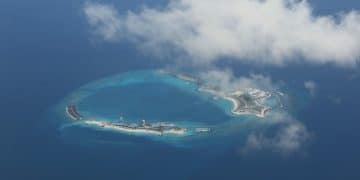Middle East Instability: Implications for US National Security

The current instability in the Middle East presents significant implications for US national security, ranging from increased threats of terrorism and cyberattacks to economic disruptions and challenges to US foreign policy objectives.
The Middle East has long been a region of geopolitical significance, and the current instability only amplifies its importance for the United States. Understanding What are the Implications of the Current Instability in the Middle East for US National Security? is crucial for policymakers, analysts, and citizens alike as it shapes decisions that affect our safety and economic stability.
Understanding the Roots of Instability
The Middle East’s present volatility stems from a tangled web of historical, political, and economic factors. Examining these roots is essential to comprehending the depth and breadth of the current turmoil and its cascading consequences for U.S. national security.
Historical Grievances and Colonial Legacies
Much of the region’s existing borders were drawn arbitrarily by colonial powers, disregarding existing ethnic and sectarian divisions. This has led to enduring conflicts between nations and within them. The legacy of colonialism continues to fuel resentment and instability.
Political Authoritarianism and Lack of Representation
Many Middle Eastern countries are governed by authoritarian regimes that suppress dissent and fail to provide adequate political representation for their populations. This leads to widespread frustration and, in some cases, violent uprisings. The absence of democratic institutions exacerbates instability.

Economic Disparities and Resource Competition
Significant disparities in wealth exist both within and between countries in the region. Competition for valuable resources like oil and water further intensifies rivalries and conflicts. Addressing these economic grievances is vital for long-term stability.
- Exploitation of sectarian divisions by political actors fuels conflict.
- The rise of non-state actors like ISIS challenges state authority.
- External interference from global powers complicates regional dynamics.
In summary, the roots of instability in the Middle East are multi-layered, including unresolved historical issues, oppressive political systems, and vast economic gaps. Understanding these components is critical to anticipating and mitigating the implications for U.S. national security.
The Direct Threat of Terrorism
One of the most immediate and palpable consequences of Middle Eastern instability is the increased threat of terrorism. The region has long been a breeding ground for extremist groups, and ongoing conflicts provide fertile ground for their expansion and recruitment.
The Proliferation of Extremist Groups
Groups like ISIS and al-Qaeda have exploited power vacuums created by civil wars and state failures to establish a foothold in the region. These groups pose a direct threat to U.S. interests both at home and abroad.
The Risk of Foreign Fighters Returning Home
Thousands of foreign fighters have traveled to the Middle East to join extremist groups. The potential return of these battle-hardened individuals to their home countries poses a significant security risk as they may carry out attacks or inspire others to do so.
The Online Radicalization Threat
Extremist groups use the internet to spread their ideology and recruit new members. This online radicalization can reach individuals anywhere in the world, including the United States, posing a constant threat to national security.

- Increased border security measures to prevent the entry of foreign fighters.
- Enhanced intelligence gathering to track and disrupt terrorist networks.
- Counter-radicalization programs to address the root causes of extremism.
Ultimately, the terrorist threat stemming from Middle Eastern instability is multifaceted and requires a holistic approach. This includes not only military action but also diplomatic efforts, intelligence sharing, and addressing the underlying conditions that foster extremism.
Cybersecurity Vulnerabilities
Beyond traditional terrorism, the current instability in the Middle East also raises serious concerns about cybersecurity vulnerabilities. State and non-state actors in the region are increasingly leveraging cyber warfare as a tool to achieve their objectives, posing a significant threat to U.S. infrastructure and national security.
State-Sponsored Cyberattacks
Some countries in the Middle East have developed sophisticated cyber capabilities and are using them to target their adversaries, including the United States. These attacks can disrupt critical infrastructure, steal sensitive information, and spread disinformation.
Non-State Cyber Actors
Extremist groups and criminal organizations in the region are also becoming more adept at using cyber warfare. They may target U.S. businesses, government agencies, or individuals to further their agendas or generate revenue.
The Challenge of Attribution
One of the biggest challenges in dealing with cyberattacks is attribution. It can be difficult to identify the perpetrators with certainty, making it challenging to hold them accountable.
Therefore, the increasing sophistication of cyber actors in the Middle East demands heightened cybersecurity measures, including improved network defenses, enhanced intelligence sharing, and international cooperation to deter and respond to cyberattacks. Strengthening cybersecurity is essential to protect U.S. national interests in the face of Middle Eastern instability.
Economic Repercussions
Instability in the Middle East has profound economic repercussions for the United States. The region is a critical source of oil and natural gas, and disruptions to supply can drive up energy prices, impact global markets, and affect the U.S. economy.
Oil Price Volatility
Conflicts and political turmoil in the Middle East can disrupt oil production and transportation, leading to price spikes and volatility. This can have a cascading effect on the U.S. economy, increasing costs for businesses and consumers.
Disruptions to Trade and Investment
Instability can also disrupt trade routes and discourage foreign investment in the region. This can hurt U.S. businesses that rely on Middle Eastern markets or supply chains.
Humanitarian Crises and Economic Strain
Conflicts in the Middle East often lead to humanitarian crises, creating large numbers of refugees and displacing populations. This can put a strain on resources in neighboring countries and require international assistance. These crises have economic as well as moral implications for the US.
In conclusion, the economic repercussions of Middle Eastern instability are far-reaching and can have a significant impact on the United States. Maintaining stable relationships in the region and diversifying energy sources can serve as mitigating efforts.
The Impact on U.S. Foreign Policy
The instability in the Middle East presents significant challenges to U.S. foreign policy objectives. Washington has long sought to promote peace, stability, and democracy in the region, but these efforts are complicated by ongoing conflicts and the rise of extremist groups.
Balancing Competing Interests
The U.S. must navigate a complex web of competing interests in the Middle East. It has alliances with some countries that are adversaries of others, requiring careful diplomacy to avoid escalating conflicts.
The Dilemma of Intervention
The U.S. faces a difficult choice between intervening in regional conflicts to protect its interests and avoiding entanglement in costly and protracted wars. Each approach carries risks and potential consequences.
The Challenge of Promoting Democracy
The U.S. has long advocated for democratic reforms in the Middle East, but these efforts have often met with resistance from authoritarian regimes. Promoting democracy in a volatile region requires a nuanced approach that considers local context and avoids imposing solutions from the outside.
- Prioritize diplomatic engagement and conflict resolution.
- Support regional partners in their efforts to combat terrorism and promote stability.
- Focus on addressing the root causes of instability, such as poverty, inequality, and political repression.
In essence, navigating these foreign policy challenges requires a strategic approach that balances competing interests, avoids costly entanglements, and promotes long-term stability.
The Humanitarian Crisis and Moral Responsibility
The ongoing instability in the Middle East has unleashed a massive humanitarian crisis, with millions of people displaced from their homes and in desperate need of assistance. This crisis presents a moral challenge for the United States, which has a long history of providing humanitarian aid around the world.
The Plight of Refugees and Internally Displaced Persons
Millions of people have been forced to flee their homes due to conflicts in Syria, Yemen, Iraq, and other countries in the region. These refugees and internally displaced persons face enormous challenges, including lack of food, shelter, medical care, and education.
The Role of Humanitarian Organizations
Many international and local humanitarian organizations are working to provide assistance to those in need. However, they often face significant obstacles, including security risks, limited access, and insufficient funding.
The Need for International Cooperation
Addressing the humanitarian crisis in the Middle East requires a coordinated international effort. The U.S. can play a leading role by providing financial assistance, logistical support, and diplomatic pressure to ensure that aid reaches those who need it most.
The humanitarian crisis requires the United States to act responsibly and compassionately. By providing assistance, supporting humanitarian organizations, and working to address the root causes of displacement, the U.S. can help alleviate suffering and promote stability in the region.
| Key Point | Brief Description |
|---|---|
| 🌍 Root Causes | Historical grievances, political repression, and economic disparities fuel instability. |
| 💣 Terrorism Threat | Extremist groups exploit instability, posing a direct threat to U.S. interests and allies. |
| 💻 Cybersecurity Risks | Cyberattacks from state and non-state actors target U.S. infrastructure and data. |
| 💸 Economic Impact | Oil price volatility and trade disruptions affect the U.S. and global economies. |
FAQ
▼
Conflicts and political turmoil in the Middle East can disrupt oil production and transportation routes, leading to price increases and volatility in global oil markets due to supply concerns.
▼
The U.S. has historically played a significant role in the Middle East through diplomatic engagement, military interventions, and providing support to allies in the region to protect its interests.
▼
Extremist groups operating in the Middle East pose a direct threat to the United States by plotting and inspiring attacks on U.S. soil and targeting U.S. interests abroad.
▼
The primary drivers of instability are historical grievances, political authoritarianism, economic disparities, sectarian conflicts, and external interference by global powers vying for control.
▼
The U.S. can foster stability by prioritizing diplomatic engagement, supporting regional partners’ efforts to combat terrorism, and addressing the root causes of instability such as poverty and inequality.
Conclusion
In conclusion, the current instability in the Middle East poses a complex and multifaceted challenge to U.S. national security. From the threat of terrorism and cyberattacks to economic repercussions and foreign policy dilemmas, the implications are far-reaching and require a comprehensive and strategic response. Addressing these challenges effectively will require a combination of diplomatic engagement, military strength, economic assistance, and a commitment to promoting human rights and democracy in the region.





